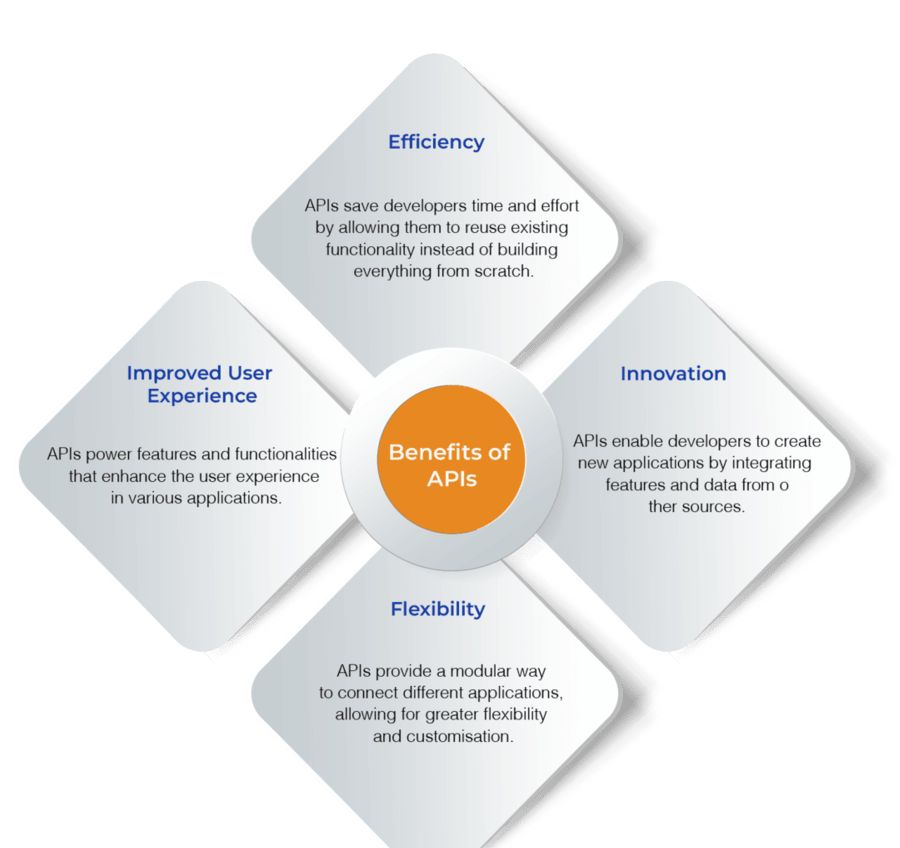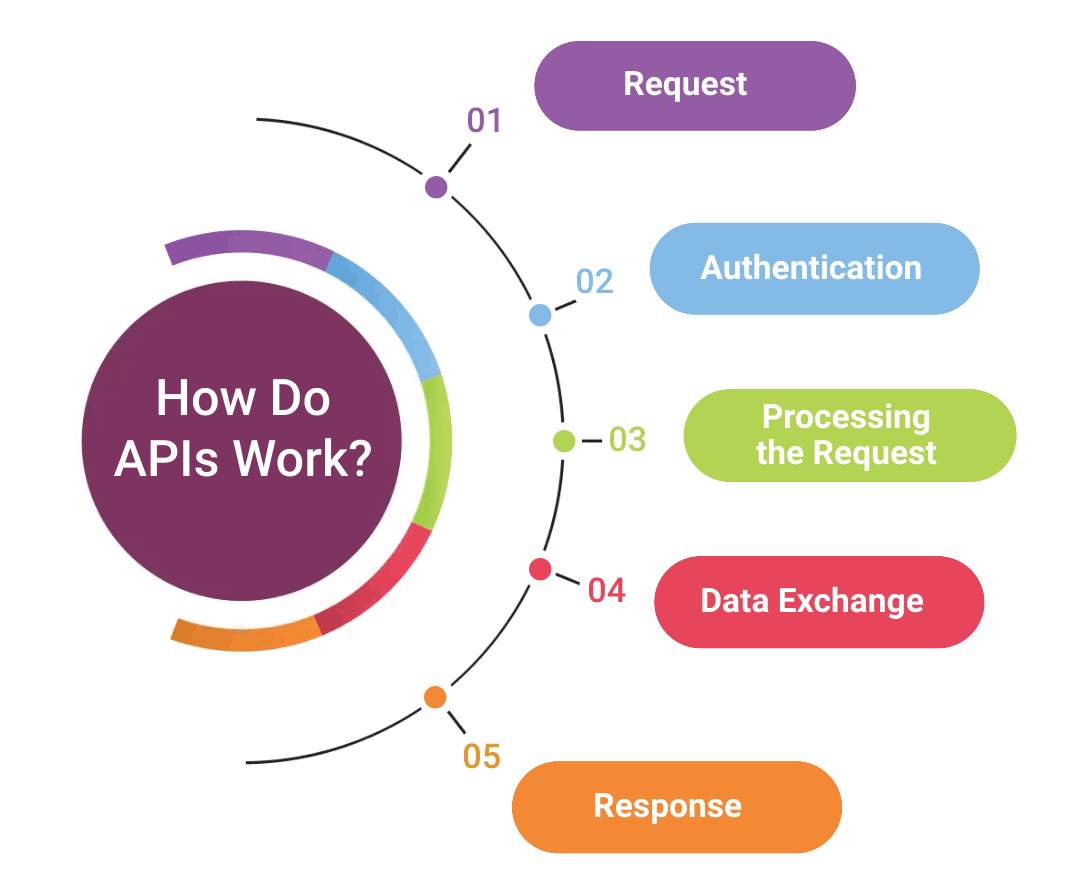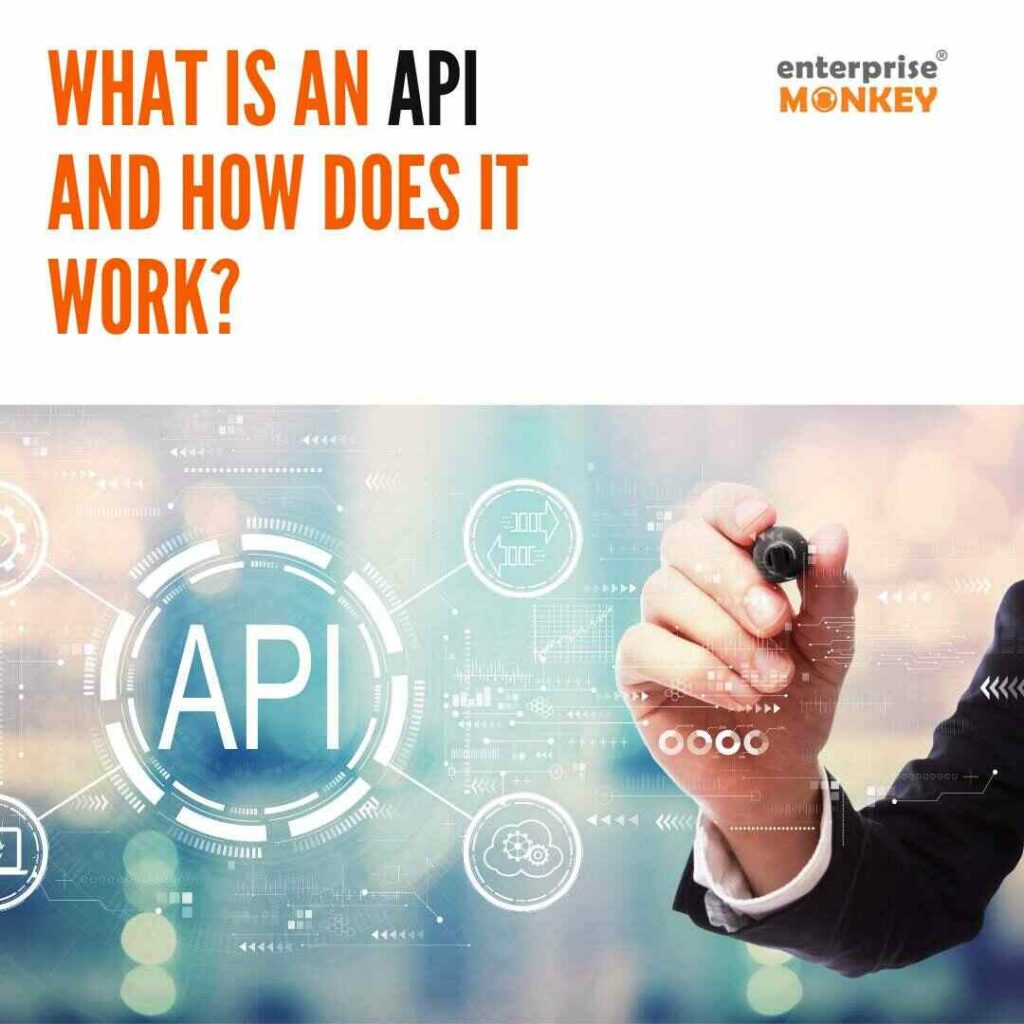Ever wonder how your favourite apps seem to magically talk to each other? How does your weather app know the forecast, or how a travel booking site retrieves flight information from different airlines? The secret lies in APIs (Application Programming Interfaces).
These behind-the-scenes messengers are the powerhouses driving many digital interactions we take for granted.
In today’s digital era, where interconnectedness and seamless integration are paramount, APIs, also known as Application Programming Interfaces, have emerged as the backbone of modern mobile app development.
Think of APIs as messengers. They’re like the delivery person taking your request to the provider and returning the response. They facilitate data exchange and functionalities between different applications and systems, driving innovation and efficiency across industries.

Here, we will delve into the fundamental concepts of APIs, demystify their workings, and explore their real-world applications. We’ll also talk about their benefits, use cases and various types that will help you get started with your project.
What is an API?
By understanding APIs, you gain a deeper appreciation for the complex web of connections that power the digital tools we use every day.
An API, which stands for Application Programming Interface, acts as a middleman between different software applications. It allows them to communicate with each other and exchange data in a structured way.
| Imagine it like a waiter in a restaurant: you (the application) tell the waiter (the API) what you want (data or a function), and the waiter relays your request to the kitchen (the other application) and brings you back your food (the response). |
An API is a set of protocols, tools, and definitions that allows different software applications to communicate and interact with each other and ensure smooth data exchange between different programs.
It defines how software components should interact, making it easier for developers to integrate and use functionalities from other applications or services without understanding their underlying codebase.

APIs are bridges that enable seamless communication and data exchange between diverse systems, driving interoperability and facilitating the creation of robust software solutions.
Case Study: Airbnb’s Use of Google Maps API for Enhanced User Experience
To understand API better, you must read this case study, which explains how Airbnb utilises the key factors of mobile app development and API functionalities to improve user experience and support app success.
Airbnb is a global online marketplace that connects travellers with hosts offering unique accommodations worldwide.
API technology has been crucial in Airbnb’s success as a leading online travel marketplace. One of Airbnb’s key features is its interactive map functionality, which allows users to search for listings based on location.
Let us see how Airbnb leverages the Google Maps API to offer valued services:
- Integration of Google Maps API
The API allows Airbnb to display map markers for listings, show nearby amenities, and enable users to visualise the neighbourhood before booking. - Enhanced Search and Filtering
By leveraging the Google Maps API’s geocoding and geolocation capabilities, Airbnb enables users to search for listings based on specific criteria such as proximity to landmarks, neighbourhoods, or points of interest. - Interactive Map Features
The integration of Google Maps API enables Airbnb to offer interactive map features such as zooming, panning, and street view. - Real-Time Availability and Pricing
Airbnb integrates real-time data from its platform with the Google Maps API to display availability and pricing information directly on the map.
By integrating the Google Maps API into its platform, Airbnb has enhanced its user experience, improved search and filtering capabilities, provided valuable location-based services, and facilitated seamless navigation for hosts and guests.
| Google Maps API
Google Maps API allows developers to embed interactive maps, geocoding, routing, and geolocation features into their applications. It provides functionalities like displaying locations, calculating distances, finding directions, and integrating with location-based services. Businesses use Google Maps API for applications such as ride-sharing, delivery tracking, and location-based search. |
How Do APIs Work?
API (Application Programming Interfaces) architecture isn’t complicated to understand if you know the basics. The API is the mid-layer between the client and server, where the client sends the application, and the server responds with an exact or related response.
Therefore, APIs define a set of rules, protocols, and tools that enable different software applications to communicate and interact with each other.

1. Request
It begins with a request initiated by the application given by the client (such as a web browser or mobile app) to access a service or resource provided by another application or system. The request typically includes specific instructions or data the client wants to retrieve, modify, or interact with.
2. Authentication
Before processing the request, the API may require authentication to verify the identity and permissions of the client making the request. This step ensures only authorised users or applications can access the requested resources. Authentication mechanisms can include API keys, OAuth tokens, or other forms of secure authentication.
3. Processing the Request
Once authenticated, the API processes the client’s request according to the defined rules and protocols. This may involve querying databases, performing calculations, executing business logic, accessing external services, or retrieving data from other systems.
4. Data Exchange
The API facilitates data exchange between the client and server in a structured format. Standard data formats used in API communication include JSON (JavaScript Object Notation), XML (eXtensible Markup Language), or even binary formats. The data exchanged includes request parameters, response payloads, error messages, and metadata.
5. Response
After processing the request and performing the necessary operations, the API generates a response containing the requested information or an acknowledgment of the action performed. The response is then returned to the client application, typically accompanied by an appropriate HTTP status code (e.g., 200 for success, 404 for not found, etc.).
| Error Handling
In case of errors or exceptions during the request processing, the API returns an error response with relevant error codes, messages, and details. This allows the client application to handle errors efficiently, provide meaningful feedback to users, and take appropriate corrective actions if needed. |
Types of APIs
APIs can be categorised into various types based on their functionality, design, or use cases. Below are the main categories of APIs based on their access level, architecture or protocol:

Types of APIs by Access Level
- Public APIs (Open APIs)
These are freely available for anyone to use. They often require registration and an API key for security purposes, but the core functionality is accessible to all developers. Weather, social media platforms, and map services often provide public APIs. - Partner APIs
These are granted access only to specific authorised developers or companies. Partners may need to go through an application process and potentially pay a fee to use the API. Financial institutions and data aggregators often share information with approved businesses with partner APIs. - Internal APIs
These are designed for internal use within a single organisation. They allow different teams within a company to share data and functionality between their private applications. Internal APIs are crucial for streamlining communication and development processes within large organisations.
Types of APIs by Technical Architecture
- REST API (REpresentational State Transfer)
This is the most common type of API architecture. REST APIs follow a set of design principles that emphasise lightweight, stateless communication. They use HTTP verbs (GET, POST, PUT, DELETE) to interact with data and are generally easy to integrate with various applications. - SOAP API (Simple Object Access Protocol)
SOAP APIs are a heavier alternative to REST. They use XML for data exchange and offer a stricter communication protocol. While less common than REST nowadays, SOAP APIs are still used in some enterprise applications that require high security and reliability. - RPC API (Remote Procedure Calls)
These APIs allow applications to execute procedures on a remote server. They can be implemented using different protocols, such as XML-RPC or JSON-RPC.
Types of APIs by Protocol
GraphQL APIs
This is a newer API technology that is gaining traction. GraphQL is a query language for APIs that allows clients to request specific data from the server.
Enable clients to define the response structure they need. This flexibility reduces data over- and under-fetching, making GraphQL APIs efficient for fetching nested or related data in a single request.
WebSocket APIs
WebSocket APIs enable real-time, bidirectional communication between clients (web browsers or mobile apps) and servers.
Unlike traditional HTTP-based APIs, which follow a request-response model, WebSocket APIs allow for persistent connections. This makes them ideal for applications that require low latency and continuous data exchange, such as chat apps and real-time dashboards.
JSON-RPC and XML-RPC APIs
JSON-RPC (JSON Remote Procedure Call) and XML-RPC (XML Remote Procedure Call) are protocols that enable remote procedure calls (RPCs) between distributed systems using JSON or XML as the data format.
These APIs facilitate remote method invocation and data exchange, allowing applications to interact seamlessly across different platforms and programming languages.
Real-World Examples of API
APIs are all around us. It is the buzzword that silently works behind the scenes to create your mobile app to compete for growth, make our digital experiences smooth, and enhance efficiency. Here are a few real-world examples of how APIs are used in everyday applications:
Social Media Integration APIs
- Facebook Graph API
Facebook provides the Graph API, which allows developers to access and interact with Facebook’s social graph data, such as user profiles, posts, photos, and events.
Developers can integrate this API into their applications to enable features like social login, posting to Facebook timelines, retrieving user data, and analysing social interactions.
Payment Gateway APIs
- Stripe API
Stripe offers an API enabling businesses to accept online payments securely. Developers can integrate Stripe’s API into e-commerce websites or mobile apps to process payments, manage subscriptions, handle refunds, and perform other payment-related tasks.
The API supports various payment methods, currencies, and customisable checkout experiences.
Weather Data APIs
- OpenWeatherMap API
OpenWeatherMap offers a weather data API that provides real-time and forecast weather information worldwide. Developers can integrate this API into weather applications, travel apps, and smart devices to fetch weather conditions, temperature, humidity, wind speed, and precipitation data for specific locations.
E-commerce APIs
- Amazon MWS (Marketplace Web Service) API
Amazon MWS API allows sellers to programmatically manage their inventory, orders, payments, and shipping on Amazon’s marketplace. Developers can use this API to automate tasks like listing products, updating prices, processing orders, and tracking shipments within the Amazon ecosystem.
Social Media Analytics APIs
- Twitter API
Twitter offers several APIs, including the Twitter REST API and Streaming API, that allow developers to access Twitter’s social media data, such as tweets, users, hashtags, and trends. Developers can use these APIs to analyse social media interactions, monitor sentiment, track hashtags, and create custom dashboards for social media analytics.
So the next time when you discuss with your mobile app development partner about the creation of your app that retrieves data or offers seamless functionality, remember the invisible role that APIs play in making it all possible.
Conclusion
| APIs enable seamless communication and integration between diverse systems and modern software development. They empower developers to create innovative applications, leverage external services, and enhance user experiences. |
As a business owner, if you want to create an innovative and user-friendly app, it is the best time to partner with a professional mobile development company. They can offer you the best and expert services for your business mobile application development by enduring the power of API.
Therefore, open the world of possibilities and harness the power of APIs like social media integrations, payment gateways, maps and geolocation services, and communication tools to your company’s mobile app to deliver robust solutions that meet the evolving needs of users.













